NCERT Solutions for Class 9 Maths Exercise 11.1 book solutions are available in PDF format for free download. These ncert book chapter wise questions and answers are very helpful for CBSE board exam. CBSE recommends NCERT books and most of the questions in CBSE exam are asked from NCERT text books. Class 9 Maths chapter wise NCERT solution for Maths Book for all the chapters can be downloaded from our website and myCBSEguide mobile app for free.
NCERT solutions for Class 9 Maths Constructions Download as PDF
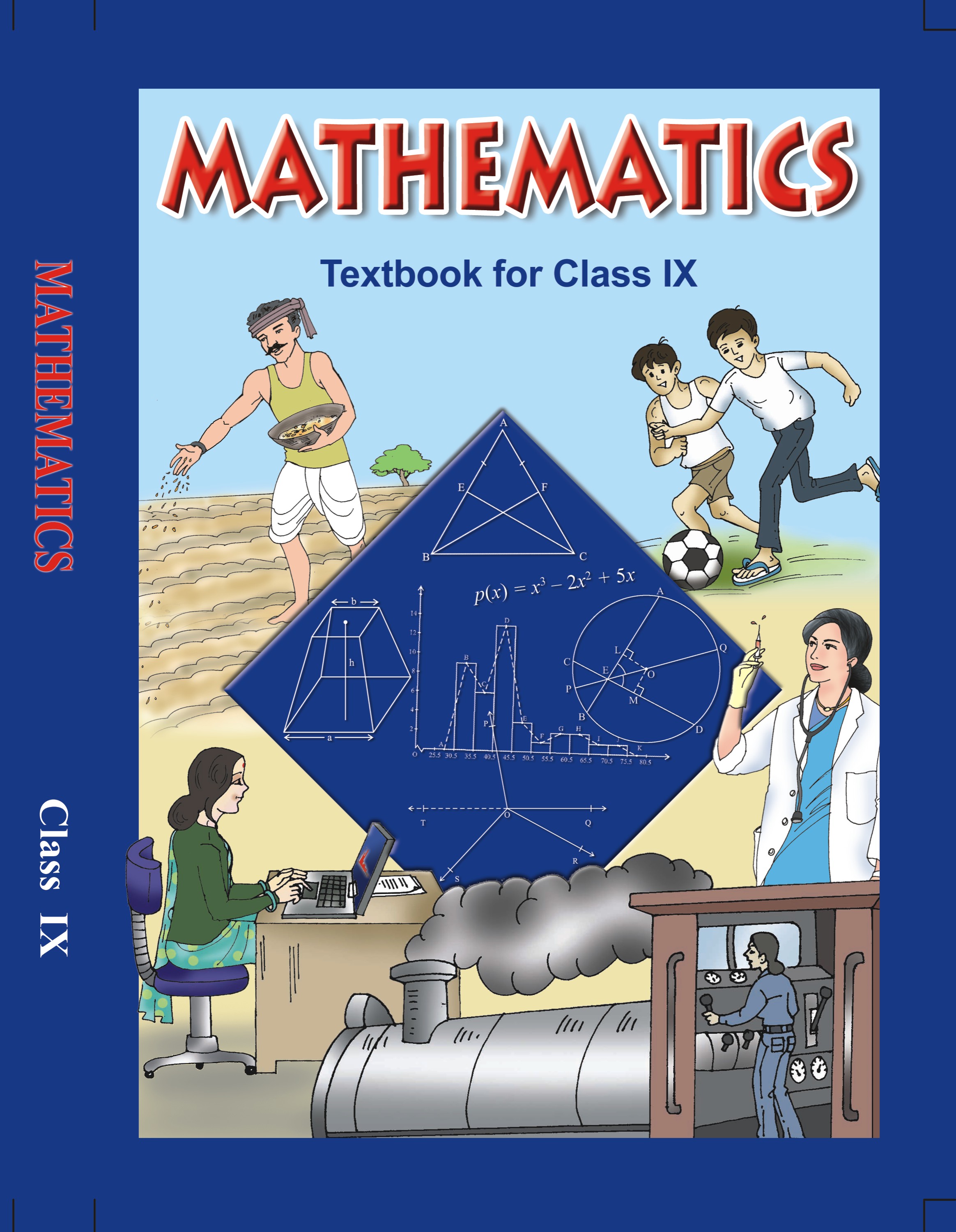
NCERT Solutions for Class 9 Mathematics Constructions
1. Construct an angle of  at the initial point of a given ray and justify the construction.
at the initial point of a given ray and justify the construction.
Ans. Steps of construction:

(a) Draw a ray OA.
(b) With O as centre and convenient radius, draw an arc LM cutting OA at L.
(c) Now with L as centre and radius OL, draw an arc cutting the arc LM at P.
(d) Then taking P as centre and radius OL, draw an arc cutting arc PM at the point Q.
(e) Join OP to draw the ray OB. Also join O and Q to draw the OC. We observe that:
 AOB =
AOB =  BOC =
BOC = 
(f) Now we have to bisect  BOC. For this, with P as centre and radius greater than
BOC. For this, with P as centre and radius greater than  PQ draw an arc.
PQ draw an arc.
(g) Now with Q as centre and the same radius as in step 6, draw another arc cutting the arc drawn in step 6 at R.
(h) Join O and R and draw ray OD.
Then  AOD is the required angle of
AOD is the required angle of 

Justification:
Join PL, then OL = OP = PL [by construction]
Therefore  OQP is an equilateral triangle and
OQP is an equilateral triangle and  POL which is same as
POL which is same as  BOA is equal to
BOA is equal to 
Now join QP, then OP = OQ = PQ [ by construction]
Therefore  OQP is an equilateral triangle.
OQP is an equilateral triangle.

 POQ which is same as
POQ which is same as  BOC is equal to
BOC is equal to 
By construction OD is bisector of  BOC.
BOC.

 DOC =
DOC =  DOB =
DOB =  BOC =
BOC = 
Now,  DOA =
DOA =  BOA +
BOA +  DOB
DOB

 DOA =
DOA = 

 DOA =
DOA = 
NCERT Solutions for Class 9 Maths Exercise 11.1
2. Construct an angle of  at the initial point of a given ray and justify the construction.
at the initial point of a given ray and justify the construction.
Ans. Steps of construction:

(a) Draw a ray OA.
(b) With O as centre and convenient radius, draw an arc LM cutting OA at L.
(c) Now with L as centre and radius OL, draw an arc cutting the arc LM at P.
(d) Then taking P as centre and radius OL, draw an arc cutting arc PM at the point Q.
(e) Join OP to draw the ray OB. Also join O and Q to draw the OC. We observe that: AOB =
AOB =  BOC =
BOC = 
(f) Now we have to bisect  BOC. For this, with P as centre and radius greater than
BOC. For this, with P as centre and radius greater than  PQ draw an arc.
PQ draw an arc.
(g) Now with Q as centre and the same radius as in step 6, draw another arc cutting the arc drawn in step 6 at R.
(h) Join O and R and draw ray OD. Then  AOD is the required angle of
AOD is the required angle of 
(i) With L as centre and radius greater than  LS, draw an arc.
LS, draw an arc.
(j) Now with S as centre and the same radius as in step 2, draw another arc cutting the arc draw in step 2 at T.
(k) Join O and T and draw ray OE.
Thus OE bisects  AOD and therefore
AOD and therefore  AOE =
AOE =  DOE =
DOE = 
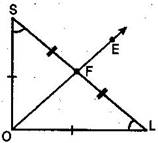
Justification:
Join LS then  OLS is isosceles right triangle, right angled at O.
OLS is isosceles right triangle, right angled at O.
 OL = OS
OL = OS
Therefore, O lies on the perpendicular bisector of SL.
 SF = FL
SF = FL
And  OFS =
OFS =  OFL [Each
OFL [Each  ]
]
Now in  OFS and
OFS and  OFL,
OFL,
OF = OF [ Common]
OS = OL [By construction]
SF = FL [Proved]

 OFS
OFS  OFL [By SSS rule]
OFL [By SSS rule]

 SOF =
SOF =  LOF [By CPCT]
LOF [By CPCT]
Now  SOF +
SOF +  LOF =
LOF =  SOL
SOL

 SOF +
SOF +  LOF =
LOF = 
 2
2 LOF =
LOF = 

 LOF =
LOF = 
And  AOE =
AOE = 
NCERT Solutions for Class 9 Maths Exercise 11.1
3. Construct the angles of the following measurements:
(i) 
(ii) 
(iii) 
Ans. (i) Steps of construction: 
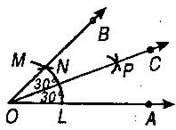
(a) Draw a ray OA.
(b) With O as centre and a suitable radius, draw an arc LM that cuts OA at L.
(c) With L as centre and radius OL, draw an arc to cut LM at N.
(d) Join O and N draw ray OB. Then  AOB =
AOB = 
(e) With L as centre and radius greater than  LN, draw an arc.
LN, draw an arc.
(f) Now with N as centre and same radius as in step 5, draw another arc cutting the arc drawn in step 5 at P.
(g) Join O and P and draw ray OC. Thus OC bisects  AOB and therefore
AOB and therefore  AOC =
AOC =  BOC =
BOC = 
(ii) Steps of construction: 
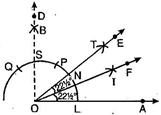
(a) Draw a ray OA.
(b) With O as centre and convenient radius, draw an arc LM cutting OA at L.
(c) Now with L as centre and radius OL, draw an arc cutting the arc LM at P.
(d) Then taking P as centre and radius OL, draw an arc cutting arc PM at the point Q.
(e) Join OP to draw the ray OB. Also join O and Q to draw the OC. We observe that:
 AOB =
AOB =  BOC =
BOC = 
(f) Now we have to bisect  BOC. For this, with P as centre and radius greater than
BOC. For this, with P as centre and radius greater than  PQ draw an arc.
PQ draw an arc.
(g) Now with Q as centre and the same radius as in step 6, draw another arc cutting the arc drawn in step 6 at R.
(h) Join O and R and draw ray OD. Then  AOD is the required angle of
AOD is the required angle of 
(i) With L as centre and radius greater than  LS, draw an arc.
LS, draw an arc.
(j) Now with S as centre and the same radius as in step 2, draw another arc cutting the arc draw in step 2 at T.
(k) Join O and T and draw ray OE. Thus OE bisects  AOD and therefore
AOD and therefore  AOE =
AOE =  DOE =
DOE =  .
.
(l) Let ray OE intersect the arc of circle at N.
(m) Now with L as centre and radius greater than  LN, draw an arc.
LN, draw an arc.
(n) With N as centre and same radius as in above step and draw another arc cutting arc drawn in above step at I.
(o) Join O and I and draw ray OF. Thus OF bisects  AOE and therefore
AOE and therefore  AOF =
AOF =  EOF =
EOF =  .
.
(iii) Steps of construction: 
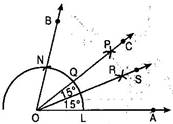
(a) Draw a ray OA.
(b) With O as centre and a suitable radius, draw an arc LM that cuts OA at L.
(c) With L as centre and radius OL, draw an arc to cut LM at N.
(d) Join O and N draw ray OB. Then  AOB =
AOB = 
(e) With L as centre and radius greater than  LN, draw an arc.
LN, draw an arc.
(f) Now with N as centre and same radius as in step 5, draw another arc cutting the arc drawn in step 5 at P.
(g) Join O and P and draw ray OC. Thus OC bisects  AOB and therefore
AOB and therefore  AOC =
AOC =  BOC =
BOC =  .
.
(h) Let ray OC intersects the arc of circle at point Q.
(i) Now with L as centre and radius greater than  LQ; draw an arc.
LQ; draw an arc.
(j) With Q as centre and same radius as in above step, draw another arc cutting the arc shown in above step at R.
(k) Join O and R and draw ray OS. Thus OS bisects  AOC and therefore
AOC and therefore  COS =
COS =  AOS =
AOS = 
NCERT Solutions for Class 9 Maths Exercise 11.1
4. Construct the following angles and verify by measuring them by a protactor:
(i) 
(ii) 
(iii) 
Ans. (i) Step of construction of 
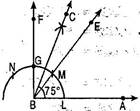
(a) Draw  ABE =
ABE =  and
and  ABF =
ABF =  . [ Follow the same steps as done in Question 1 and Question 3 (i)]
. [ Follow the same steps as done in Question 1 and Question 3 (i)]
(b) Let ray BF intersects the arc of circle at G.
(c) Now with M as centre and radius greater than  MG draw an arc.
MG draw an arc.
(d) With G as centre and with same radius as in step (c), draw an arc which intersects the previous arc at point H.
(e) Draw a ray BC passing through H which bisects  EBF.
EBF.
Thus  ABC =
ABC =  is the required angle.
is the required angle.
Justification:
 EBF =
EBF =  ABF –
ABF –  ABE =
ABE = 
Now  EBF =
EBF =  CBF =
CBF =  EBF =
EBF =  [
[ BC is the bisector of
BC is the bisector of  EBF]
EBF]

 ABC =
ABC =  ABE +
ABE +  EBC =
EBC = 
(ii) Steps of construction of 
NCERT Solutions for Class 9 Maths Exercise 11.1
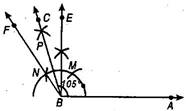
(a) Draw  ABE =
ABE =  and
and  ABF =
ABF = 
(b) Let ray BE intersects the arc of circle at M and ray BF intersects the arc of circle N.
(c) With point M as centre and radius greater than  MN, draw an arc.
MN, draw an arc.
(d) With N as centre and with same radius as in step (c), draw another arc which intersects the previous arc at P.
(e) Draw a ray BC passing through P which bisects  EBF.
EBF.
Thus  ABC =
ABC =  is the required angle.
is the required angle.
Justification:
 EBF =
EBF =  ABF –
ABF –  ABE=
ABE= 
Now  EBC =
EBC =  CBF =
CBF =  EBF =
EBF =  [
[ BC is the bisector of
BC is the bisector of  EBF]
EBF]

 ABC =
ABC =  ABE +
ABE +  EBC =
EBC = 
(iii) Steps of construction of 
NCERT Solutions for Class 9 Maths Exercise 11.1
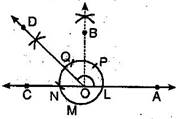
(a) Draw a ray OA.
(b) With O as centre and convenient radius, draw an arc LM (having length more than the semicircle) cutting OA at L.
(c) Now with L as centre and radius = OL; draw an arc cutting the arc LM at P.
(d) Then taking P as centre and radius OL, draw an arc cutting arc PM at Q.
(e) Now bisect  POQ by ray OB, we get
POQ by ray OB, we get  AOB =
AOB = 
(f) Now taking Q as centre and radius OL, draw an arc cutting QM at N.
(g) Join O and N to draw the ray OC.
Thus we get  AOC =
AOC = 

 BOC =
BOC =  AOB =
AOB = 
(h) Now bisect  BOC by ray OD.
BOC by ray OD.
Then  AOD is the required angle of
AOD is the required angle of 
 AOD =
AOD =  AOB +
AOB +  BOD =
BOD = 
NCERT Solutions for Class 9 Maths Exercise 11.1
5. Construct an equilateral triangle, given its side and justify the construction.
Ans. Steps of construction:
(a) Draw a line segment BC of length 6 cm.
(b) At B draw  XBC =
XBC = 
(c) Draw perpendicular bisector PQ of line segment BC.
(d) Let A and D be the points where PQ intersects the ray BX and side BC respectively.
(e) Join AC.
Thus ABC is the required equilateral triangle.
Justification:
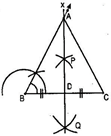
In right triangle ADB and right triangle ADC,
AD = AD [Common]
 ADB =
ADB =  ADC =
ADC =  [By construction]
[By construction]
BD = CD [By construction]

 ADB
ADB  ADC [By SAS congruency]
ADC [By SAS congruency]

 B =
B =  C =
C =  [By CPCT]
[By CPCT]

 A =
A =  (
( B +
B +  C)
C)
=  =
=  =
= 

 A =
A =  B =
B =  C =
C = 

 ABC is an equilateral triangle.
ABC is an equilateral triangle.
NCERT Solutions for Class 9 Maths Exercise 11.1
NCERT Solutions for Class 9 Maths PDF (Download) Free from myCBSEguide app and myCBSEguide website. Ncert solution class 9 Maths includes text book solutions from Mathematics Book. NCERT Solutions for CBSE Class 9 Maths have total 15 chapters. 9 Maths NCERT Solutions in PDF for free Download on our website. Ncert Maths class 9 solutions PDF and Maths ncert class 9 PDF solutions with latest modifications and as per the latest CBSE syllabus are only available in myCBSEguide.
CBSE app for Class 9
To download NCERT Solutions for Class 9 Maths, Computer Science, Home Science,Hindi ,English, Social Science do check myCBSEguide app or website. myCBSEguide provides sample papers with solution, test papers for chapter-wise practice, NCERT solutions, NCERT Exemplar solutions, quick revision notes for ready reference, CBSE guess papers and CBSE important question papers. Sample Paper all are made available through the best app for CBSE students and myCBSEguide website.

Test Generator
Create question paper PDF and online tests with your own name & logo in minutes.
Create Now
Learn8 App
Practice unlimited questions for Entrance tests & government job exams at ₹99 only
Install Now